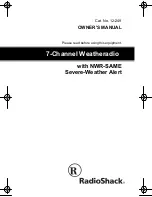
28
Special Functions on FM
The RDS-Q special function remains effective for approx. 1 minute
and then automatically switches to the indication of the
programme chain name. It is also possible to switch the RDS-Q
indication to the programme chain name indication by pressing
the LSB/USB button once again.
Please note:
The indication of the programme chain name is only effected if the
RDS reception quality is sufficient, and the indication of the RDS
quality is only possible if the RDS sign is indicated too.
Calling Up Alternative Frequencies (AF)
RDS (Radio Data System)
RDS is a digital information system, the signals of which are
broadcasted in addition to the FM radio programme. Your radio is
equipped for operation with this information system. It evaluates
the codes for programme identification (PI), programme service
(PS), and alternative frequencies (AF).
It is thus possible for the radio to indicate the name of the
programme chain (stations broadcasting the same programme)
and to compare the different stations of the same programme
chain.
To ensure a correct decoding of the RDS signals, certain demands
are made on the reception quality of RDS broadcasts. This is
especially true when the telescopic aerial is used for reception.
The first condition for correct RDS reception is a sufficient signal
strength. This means that the TUNING (field strength) indication
should reach its maximum deflection. A further condition is the
indication of the RDS sign. If these two conditions are met, the name
of the programme chain will be indicated within 10 seconds. If this
should not be the case, decoding of the RDS signal is probably
impaired by multipath reception (reflections). In most cases, this
distortion is not signalled through an unstable TUNING (field
strength) indication. At the most, the RDS indication might be
unstable. In technical jargon, this effect is called
The RDS reception quality is insufficient.
A special function of your unit enables the indication of the RDS
reception quality.
Pressing the LSB/USB button © switches the eight-position
alphanumeric indication to the RDS quality indication:
Q ...........
Try to improve the RDS reception quality by changing the
position of the telescopic aerial (tilt and/or rotate). This means
that as many segments as possible should be indicated. The figure
shows the maximum possible number of 16 sensitivity grades
(vertical bars).
This indication corresponds to 100 % RDS reception quality
(respectively 0 % error rate).
Especially when operating the radio inside a building, the
location of the radio can be of great importance for the RDS
reception quality. If necessary, try to install the radio at a location
giving better results.
If the RDS sign and the programme chain name are both indicated,
you can call up the alternative frequencies of this programme
chain.
Pressing the FM/RDS-AF button starts scanning of t broadcasted
alternative frequencies.
During this function, the indication AF appears in the disp l a y
( 4 ) .
The individual frequencies are then checked for their field strength
(worthy of reception or not). If the field strength suffices for correct
RDS reception, scanning is aborted. The respective frequency is
indicated and the unit switches off the muting function which has
been activated at the beginning of the scan (call-up) function. If
none of the alternative frequencies is worthy of reception the radio
tunes to the initial frequency again.
Hint
Short pressure on the FM/RDS-AF button =
the alternative frequencies are indicated in increasing
order.
Long pressure on the FM/RDS-AF button =
the alternative frequencies are indicated in decreasing order


































